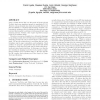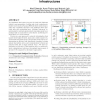SIGCOMM
2009
ACM
14 years 6 months ago
2009
ACM
Online social networks have become extremely popular; numerous sites allow users to interact and share content using social links. Users of these networks often establish hundreds...
SIGCOMM
2009
ACM
14 years 6 months ago
2009
ACM
SIGCOMM
2009
ACM
14 years 6 months ago
2009
ACM
Large, socially-driven Web 2.0 sites such as Facebook and Youtube have seen significant growth in popularity [5, 10]. However, strong demand also exists for socially-driven web s...
SIGCOMM
2009
ACM
14 years 6 months ago
2009
ACM
The analysis of social and technological networks has attracted a lot of attention as social networking applications and mobile sensing devices have given us a wealth of real data...
SIGCOMM
2009
ACM
14 years 6 months ago
2009
ACM
As virtualized data-centres become the back-end platforms behind a new generation of utility and cloud computing infrastructures (such as AmazonAWS [1]) their multi-tenancy, scale...
SIGCOMM
2009
ACM
14 years 6 months ago
2009
ACM
This paper describes a new architecture which addresses Quality of Service (QoS) by creating unique flows for applications, services, or subnets. A flow is a dedicated and indep...
SIGCOMM
2009
ACM
14 years 6 months ago
2009
ACM
Network security is gravitating towards more centralized control. Strong centralization places a heavy burden on the administrator who has to manage complex security policies and ...
SIGCOMM
2009
ACM
14 years 6 months ago
2009
ACM
Enterprise network security is typically reactive, and it relies heavily on host security and middleboxes. This approach creates complicated interactions between protocols and sys...
SIGCOMM
2009
ACM
14 years 6 months ago
2009
ACM
We present Flow-based Management Language (FML), a declarative policy language for managing the configuration of enterprise networks. FML was designed to replace the many dispara...
SIGCOMM
2009
ACM
14 years 6 months ago
2009
ACM
BGP routing policies are mainly used by network operators to enforce business relationships between Autonomous Systems (AS), and to prefer some routes over others. In this paper, ...



